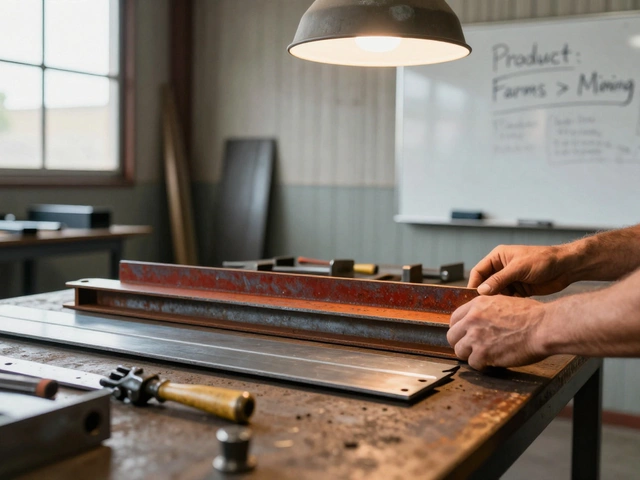What Is the Most Profitable Item to Flip in 2025? Data-Backed Picks and a Simple Playbook

You clicked hoping for a one-word answer. Here’s the truth that actually makes you money: the most profitable item to flip isn’t a single product-it’s the category where you have an information edge, fast sell-through, and pricing power. In 2025, the standouts for solo sellers are used pro-grade power tools, select electronics (cameras, routers, game consoles), discontinued LEGO, in-demand sneakers, and durable workwear. You’re aiming for items that net $30+ profit, move within 30 days, and don’t crack in a box. Hit those three and your pile of cash grows fast.
“Secondhand is expected to grow 4x faster than traditional retail through 2028.” - thredUP 2025 Resale Market Report
TL;DR: What’s the most profitable item to flip?
- The one you can source repeatedly with a strong “information edge” and a 60%+ 90‑day sell-through. For most people in 2025, that’s used pro tools (Milwaukee/DeWalt/Makita), hot consumer electronics (mesh routers, GoPro/Sony cameras), discontinued LEGO, and brand-name sneakers/workwear in great condition.
- Quick rule to use on the spot: Buy only if you can 3x your cost or make $30+ net after fees and shipping-whichever is tougher.
- Check comps properly: Filter eBay to Sold/Completed, last 90 days, right condition and model. If at least 6 sold for every 10 listed, you’re good.
- Keep your risk low: Avoid fragile, oversized, or brand-restricted items until you know the ropes. Don’t touch counterfeit‑heavy niches unless you can authenticate.
- The answer you wanted in one line: the most profitable item to flip for most solo sellers right now is used professional-grade power tools-because demand is constant, testing is simple, parts bundles sell, and margins are fat.
How to pick profitable flips (a simple framework)
Think of flipping like a math puzzle with four dials: Demand, Margin, Velocity, and Risk. If three spin in your favor, you’ve likely found a winner. Here’s the framework I use when I’m scanning shelves with a coffee in one hand and my cat Molly yelling at me from the doorway because I’m late for dinner.
- Demand: Is it actively selling? On eBay, switch to Sold/Completed, last 90 days. Look for steady green sales, not one unicorn spike.
- Margin: Can you net 40%+ after fees and shipping, or $30+? Calculate before you buy. If you can’t clear $30, pass unless it sells in under a week.
- Velocity: What’s the 90‑day sell-through? Sold ÷ Active listings. Aim for 60%+. At 100%+, you can price a bit higher.
- Risk: Fragile? Oversized? High return rate? Brand-enforced takedowns? Pick sturdy items with simple returns. Tools beat porcelain every day.
Now, apply some guardrails so you don’t talk yourself into bad buys:
- 3x rule: Target sale price at least 3x your buy cost.
- Minimum net: $30 after all costs. You’ll thank yourself when shipping goes sideways.
- Time box: Aim for 30 days to sell. If it hasn’t sold by day 21, adjust photos/title/price.
- Category focus: Pick two categories and learn them deeply. Category knowledge beats random luck.
For 2025, general demand is strongest in categories where utility is obvious and new prices climbed: power tools, networking gear, quality workwear, camera gear, and certain hobby sets (LEGO, trading cards-but authenticate!). Clothing works if you stick to premium brands and clean condition. Media (vinyl, out-of-print games) can be gold if you can test and grade honestly.

Step-by-step: from sourcing to sale
Here’s a tight loop you can reuse weekly. It’s simple, repeatable, and keeps you from buying dust collectors.
-
Pick your two lanes: Example combo that prints in 2025-(1) Used pro tools and batteries, (2) Mesh routers and smart home hubs. You’ll learn models fast and spot bargains instantly.
-
Source intelligently:
- Local: Facebook Marketplace, Craigslist, OfferUp, yard/estate sales, community auctions, workplace surplus. Ask contractors about old gear when they upgrade.
- Retail: Big‑box clearance end caps, open‑box returns, Habitat for Humanity ReStores for tools.
- Thrift: Walk the edges first-electronics wall, tools bin, glass case. Scan barcodes when possible.
- Automation: Save searches: “Milwaukee M18,” “AX6000 router,” “Legos retired set,” “DeWalt XR battery.” Set alerts for misspellings too.
-
Check comps the right way:
- eBay: Sold + Completed, last 90 days. Match condition: new/open-box/used/for parts.
- Compute Sell‑Through: If 60+ sold and 80 active, ST = 75% (good). If 10 sold and 300 active, run.
- Fees: eBay final value fees often land around 13-15% with payment processing. Poshmark takes 20% over $15. Mercari ~13% total. Facebook Marketplace ~5% when shipping. Build these into your math.
- Shipping: Know your zones. A 5‑lb tool going coast‑to‑coast can cost $12-$18 with ground services. Add $2 buffer.
-
Test, clean, and bundle:
- Tools: Run the motor, check chuck play, test batteries under load, include a charger if margins allow.
- Electronics: Factory reset, test Wi‑Fi speeds, update firmware, include Ethernet cable.
- Apparel: Lint‑roll, treat stains, measure chest/length, photograph tags clearly.
- Bundles: Two batteries + charger often sell faster than singles at higher total margin.
-
Price with intent:
- Velocity pricing: Undercut the median by 3-5% to move fast, or price at the upper quartile with Best Offer if your photos and testing are A+.
- Endings: 9.99 pricing still works for consumer items. For premium gear, round numbers feel cleaner.
- Shipping: Offer calculated or flat rate you can beat. Free shipping can boost conversion on light items; skip it on heavy stuff.
-
Create listings that sell:
- Title formula: Brand + Model + Key Specs + Condition + Size/Capacity. Example: “Milwaukee M18 Fuel 1/2 in Hammer Drill 2804‑20 Tested, Tool‑Only.”
- Photos: Natural light, plain background, 8-12 angles. Close‑ups of wear, serials, ports.
- Honesty: Disclose every flaw. Returns drop when buyers feel informed.
-
Pack like a pro:
- Tools/electronics: Bubble wrap, void fill, double‑box for heavy or sharp‑edged tools.
- Clothing: Fold, bag, insert size/measures card to reduce “item not as described” claims.
- Print labels after you weigh and measure the boxed item-not before.
-
After-sale:
- Respond fast to messages-buyers are calmer when they hear from you.
- Track rates: Return rate over 5%? Rework your descriptions and photos.
- Reinvest: Roll profits back into the SKUs that turned within 30 days.
When I test drills, I keep a scrap plank under the workbench. Two trigger pulls, check heat, listen for grind, done. Molly supervises from a safe distance because she does not negotiate with flying sawdust.
High-ROI items to flip in 2025 (with real numbers)
Use these as starting points, not gospel. Always check your local comps.
| Category (Examples) | Typical Buy | Common Sale Price | Estimated Fees+Ship | Net Profit | ROI | 90‑Day Sell‑Through | Notes |
|---|---|---|---|---|---|---|---|
| Pro Tools (Milwaukee/DeWalt/Makita drills, impact drivers, batteries) | $20-$80 | $75-$220 | $18-$35 | $35-$120 | 60%-300% | 60%-95% | High demand, easy testing; bundles sell faster |
| Mesh Routers (AX3000-AX6000), Modems (DOCSIS 3.1) | $15-$60 | $60-$200 | $12-$28 | $25-$110 | 60%-250% | 55%-90% | Factory reset; avoid ISP‑locked units |
| Discontinued LEGO (sealed retirements) | $40-$200 | $120-$600 | $15-$50 | $50-$300+ | 50%-250%+ | 50%-85% | Check set retirement lists; beware fakes |
| Camera Gear (Sony/Canon lenses, GoPro kits) | $60-$300 | $150-$800 | $20-$80 | $50-$300+ | 40%-200% | 50%-80% | Test autofocus, stabilization; include caps |
| Sneakers (Nike/Adidas/On; in‑demand colorways) | $25-$120 | $70-$300 | $12-$25 | $25-$140 | 40%-200% | 45%-85% | Authenticate; include style code |
| Workwear (Carhartt, Patagonia, Arc’teryx) | $10-$60 | $45-$220 | $10-$22 | $20-$130 | 50%-300% | 50%-80% | Measure and show wear honestly |
| Small Kitchen Appliances (Vitamix, Breville) | $20-$120 | $90-$350 | $18-$45 | $30-$180 | 40%-250% | 40%-75% | Heavy; pack well; test blades/heating |
| OBD2 Scanners/Tools (Autel, BlueDriver) | $15-$70 | $60-$240 | $12-$25 | $25-$130 | 60%-300% | 55%-85% | Update firmware; show screen working |
Three example flips to show the math:
- DeWalt 20V XR 5Ah battery + charger (thrift $40). Sold $119 + buyer paid shipping. Fees+ship ~$27. Net ~$52. Time to sell: 9 days.
- Netgear Orbi AX4200 router (local pickup $50). Sold $165 free ship. Label $14, fees ~$23. Net ~$78. Time to sell: 6 days.
- LEGO Ideas 21319 Friends Central Perk, sealed (clearance $70). Sold $180 + ship. Fees+ship ~$31. Net ~$79. Time to sell: 18 days.
What about a single “king” across most cities? If you forced me to choose: used pro tools win this year. Contractors upgrade constantly, DIY is booming, and even “for parts” tools sell. That combination is rare.

Checklists, mini‑FAQ, and next steps
Bookmark this section. It keeps you from making expensive mistakes.
Sourcing checklist (take this with you):
- Search alerts set for target models and misspellings.
- Carry a small tape, battery bank, and test bits/cables.
- Open cases. Verify model and condition. Look for cracks and missing parts.
- Scan Sold comps, match condition, count units sold in 90 days.
- Do the math: Sale price × 0.85 − shipping − cost ≥ $30 net?
- Walk away if you can’t test or comps are thin.
Listing checklist:
- Title with brand + model + key spec + condition.
- 12 clear photos; show flaws, serials, and measurements.
- Condition note: “Tested, works; minor scuffs; see photos.”
- Shipping method set; weight and dimensions accurate.
- Offer returns (30 days) to boost trust; it increases conversion more than it hurts.
Packing checklist:
- Bubble wrap item fully, protect corners/edges.
- Fill voids so nothing shifts. Shake test the box.
- Use strong tape; double‑box heavy or sharp items.
- Include a simple thank‑you note; it reduces SNAD claims.
Mini‑FAQ
- Is flipping legal? Yes. You’re reselling goods you own. Follow platform policies and local laws.
- Do I owe taxes? In most places, yes. Marketplaces issue 1099‑K (US) at certain thresholds; track cost basis. Check your country’s rules or a CPA.
- Do I need a business license? Many sell as sole proprietors. If you scale, consider a legal entity and sales tax permits where required.
- What platform is best? eBay for most hard goods; Poshmark for fashion; Mercari for small consumer goods; Facebook Marketplace for local, bulky items. Pick based on your category.
- How much to start? $100-$300 is plenty if you stick to fast movers. Reinvest profits into the SKUs that sold fastest.
- How do I avoid returns? Test thoroughly, disclose flaws, use clear photos and measurements, and pack well. Clarity up front beats arguing later.
Troubleshooting
- Nothing is selling. Recheck sell‑through. Improve photos and titles. Drop price 5-10%. Consider promoted listings on eBay for stale items.
- Low margins after shipping. Shift to smaller, denser items (batteries, lenses, routers). Use regional pricing-charge more to zones that cost more to ship.
- Too many returns. Add measurements, show flaws up close, and specify what’s tested. Tighten your categories to items you can fully test.
- Inventory pile‑up. Set a weekly listing cadence (e.g., list 5 per day). Create a 60‑day liquidation plan: cross‑list or lot items.
- Brand takedowns (VERO). Stick to safe categories. Avoid using trademarked terms like “Dupe” or “Inspired.” Use generic descriptors.
Next steps by persona
- Beginner with $150: Snipe local routers and tools. Aim for two flips at $40-$60 net each. Reinvest. Don’t buy clothing yet.
- Apartment dweller: Focus on small, high-value items (batteries, lenses, handheld tools). Store in clear bins; label by SKU.
- Suburban thrifter: Hit three stores early twice a week. Scan electronics first, then glass case, then jackets. Buy only what sells fast in your comps.
- Weekend warrior: Estate sales Saturday morning. Target garage/workshop sections for tool lots. Bundle and part out.
- Student/time‑crunched: List fewer, higher‑margin items. Use templates and a lightbox to shoot fast. Keep it to one category to reduce decision fatigue.
Final thought to keep your wallet happy: don’t chase unicorns. Chase velocity and net profit. If you get bored, switch lanes later. Money likes boring, repeatable systems-and in 2025, that system leans hard toward used pro tools and practical electronics that people need now.





